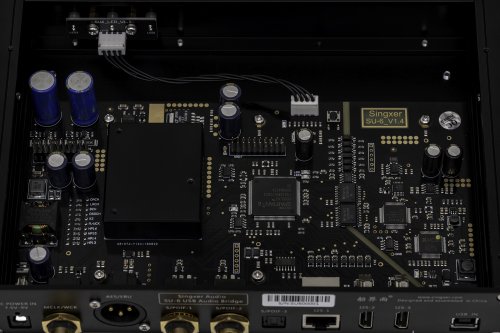whodiini
New Head-Fier
- Joined
- May 13, 2008
- Posts
- 28
- Likes
- 30
Starting a new thread for the Singxer Su-6 reclocker. Purpose is similar to the Singxer SU-1, which I dont own and the Matrix SPDIF 2, and the Mutec MC3+, both of which I own and will compare.
Just got it today, and my initial impression is that it is pretty darn good. I use these to take a USB signal from my mac mini and convert to AES/EBU that I pipe into various DACs like the Schiit Yggadrasil. I used to use a mac mini firewire output to a SPDIF converter to an Apogee Big Ben, but replaced that once firewire stopped being on macs. The Singxer SU-6 seems to have better clarity of musical lines and cleaner instrumentals. Also dynamics and bass is better. In comparison to both the Matrix and Mutec, which are no slouches. The matrix was comparable to the Mutec, and the SU-6 so far is better than both.
I will update once I run it in a few days.
I have now compared the unit with the stock power supply and with an ifi lower noise unit. I cannot hear any difference. That means the supercap must isolate the line noise pretty well. The su6 continues to perform admirably and have no issues. It is my default unit and has displaced both the matrix spdif 2 and the mutex which are both very fine units.
Just got it today, and my initial impression is that it is pretty darn good. I use these to take a USB signal from my mac mini and convert to AES/EBU that I pipe into various DACs like the Schiit Yggadrasil. I used to use a mac mini firewire output to a SPDIF converter to an Apogee Big Ben, but replaced that once firewire stopped being on macs. The Singxer SU-6 seems to have better clarity of musical lines and cleaner instrumentals. Also dynamics and bass is better. In comparison to both the Matrix and Mutec, which are no slouches. The matrix was comparable to the Mutec, and the SU-6 so far is better than both.
I will update once I run it in a few days.
I have now compared the unit with the stock power supply and with an ifi lower noise unit. I cannot hear any difference. That means the supercap must isolate the line noise pretty well. The su6 continues to perform admirably and have no issues. It is my default unit and has displaced both the matrix spdif 2 and the mutex which are both very fine units.
Last edited:




























